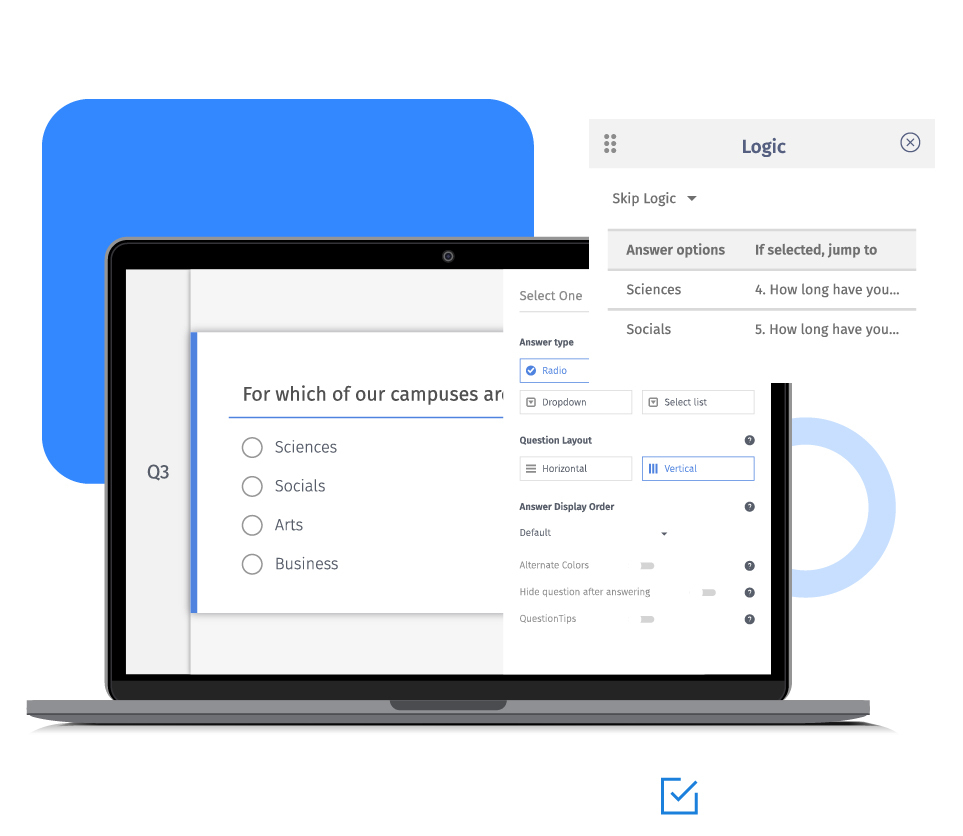Using randomizer logic in surveys
With QuestionPro surveys, you can present questions randomly by using an advanced randomization logic in your research. You can select the specific questions to be displayed in any order or choose the ones that must be skipped in randomization logic.
Randomize all questions from the list: All the questions in this category will be randomly displayed to the respondents.
Randomize display 'n' items from the list: Select specific questions that should be displayed randomly. The logic will pick a specific number of questions as configured by the administrator and display them in a non-uniform pattern.
Skip questions: Select specific questions that should be skipped for randomization logic. It implies these questions will be displayed as they are placed in the questionnaire.
Note: QuestionPro uses an advanced algorithm that displays the sections in random order. Thus, we cannot control the order of questions presented or track the order of questions dynamically.
Example of a randomizer logic
Consider the following scenario:
Questions Q1 and Q2 are common questions to be displayed in the same order. Then Q3, Q4 and Q5 are to be randomly presented to the respondents. Any one of questions Q6 and Q7 must be asked.
Q1 - Question 1
Q2 - Question 2
Q3 - Question 3
Q4 - Question 4
Q5 - Question 5
Q6 - Question 6
Q7 - Question 7
In this case, the questions Q1 and Q2 must be skipped. Q3, Q4 and Q5 must be placed in a category to display them in a random order. And finally configure the logic to randomly select one of the Q6 and Q7.
One of the possible combinations that respondents might get can be as below.
Q1 - Question 1
Q2 - Question 2
Q5 - Question 5
Q4 - Question 4
Q3 - Question 3
Q7 - Question 7
Uses of a randomizer logic
Market researchers can use randomizer logic for experimenting with the new ideas or when a sequence of question items matters. Question rotation is particularly useful when an order of things can influence the choices and decisions of respondents.
For instance, an automobile company can ask questions related to cars that exist in the market. Then they should randomly display the images of proposed models of cars and ask its participants to select their favorite design. In such situations, the order of the questions can influence the decisions of the respondents, and so block randomization can remove the order bias.
Advantages of displaying questions randomly
Eliminate bias: Survey-creators should design the questionnaire such that the sequence of questions does not affect their answers. Randomizer logic achieves this quite easily with minimum configuration.
Collect an honest opinion: Respondents share their honest opinion when they select answer options with a fresh mindset. They will tend to share their real choices and experiences if they aren't under any effect of the past questions.
Accurate data: Unbiased answers lead to reliable data and hence, accurate reports. Market researchers rely heavily on the survey reports, and so the data must be clean and precise.
How to randomize the order of questions in your surveys?
Learn how to set up and use this feature with our help file on the question randomization.
Survey Software Easy to use and accessible for everyone. Design, send and analyze online surveys.
Research Suite A suite of enterprise-grade research tools for market research professionals.
Customer Experience Experiences change the world. Deliver the best with our CX management software.
Employee Experience Create the best employee experience and act on real-time data from end to end.





